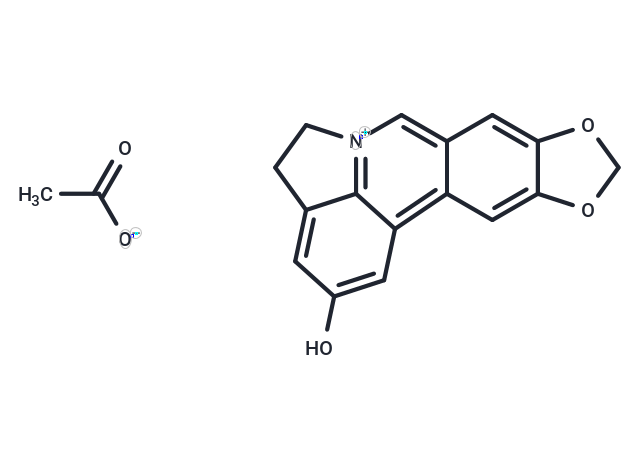Shopping Cart
- Remove All
 Your shopping cart is currently empty
Your shopping cart is currently empty

Lycobetaine acetate (Oxylycorine) is a potential biofungicide against Penicillium roqueforti and Aspergillus niger.2. Ungeremine have strong antibacterial activity against Flavobacterium columnare

| Pack Size | Price | Availability | Quantity |
|---|---|---|---|
| 1 mg | $38 | In Stock | |
| 5 mg | $81 | In Stock | |
| 10 mg | $117 | In Stock | |
| 25 mg | $192 | In Stock | |
| 50 mg | $283 | In Stock | |
| 100 mg | $418 | In Stock |
| Description | Lycobetaine acetate (Oxylycorine) is a potential biofungicide against Penicillium roqueforti and Aspergillus niger.2. Ungeremine have strong antibacterial activity against Flavobacterium columnare |
| In vitro | Lycobetaine displayed cytotoxic activity towards the 9 cancer cell lines tested, including drug-sensitive and MDR phenotypes. The IC50values obtained varied from 3.67 μM (in MDA-MB-231-BCRP breast carcinoma cells) to 75.24 μM (against in CEM/ADR5000 leukemia cells) for Lycobetaine and from 0.02 μM (against CCRF-CEM cells) to 122.96 μM (against CEM/ADR5000 cells) for doxorubicin (control drug). Lycobetaine induced ferroptosis, necroptosis, autophagy as well as apoptosis mediated by caspase activation, MMP alteration and increase ROS production[1]. |
| Cell Research | The cytotoxicity, ferroptotic and necroptotic cell death were determined by the resazurin reduction assay. Caspase activation was evaluated using the caspase-Glo assay. Flow cytometry was applied for the analysis of cell cycle analysis (PI staining), apoptosis (annexin V/PI staining), mitochondrial membrane potential (MMP) (JC-1) and reactive oxygen species (ROS) (H2DCFH-DA). Apoptotic, necroptotic and autophagic markers were determined by Western blotting. CCRF-CEM leukemia cells were used for all mechanistic studies[1]. |
| Alias | Ungerimine acetate, Oxylycorine |
| Molecular Weight | 325.32 |
| Formula | C18H15NO5 |
| Cas No. | 61221-41-8 |
| Smiles | O=C([O-])C.OC1=CC2=C3C=C4OCOC4=CC3=C[N+]5=C2C(=C1)CC5 |
| Relative Density. | no data available |
| Storage | Powder: -20°C for 3 years | In solvent: -80°C for 1 year | Shipping with blue ice. | ||||||||||
| Solubility Information | Ethanol: 1 mg/mL (3.07 mM), Sonication is recommended. DMSO: < 1 mg/mL (Insoluble) H2O: Insoluble | ||||||||||
Solution Preparation Table | |||||||||||
Ethanol
| |||||||||||

Copyright © 2015-2025 TargetMol Chemicals Inc. All Rights Reserved.